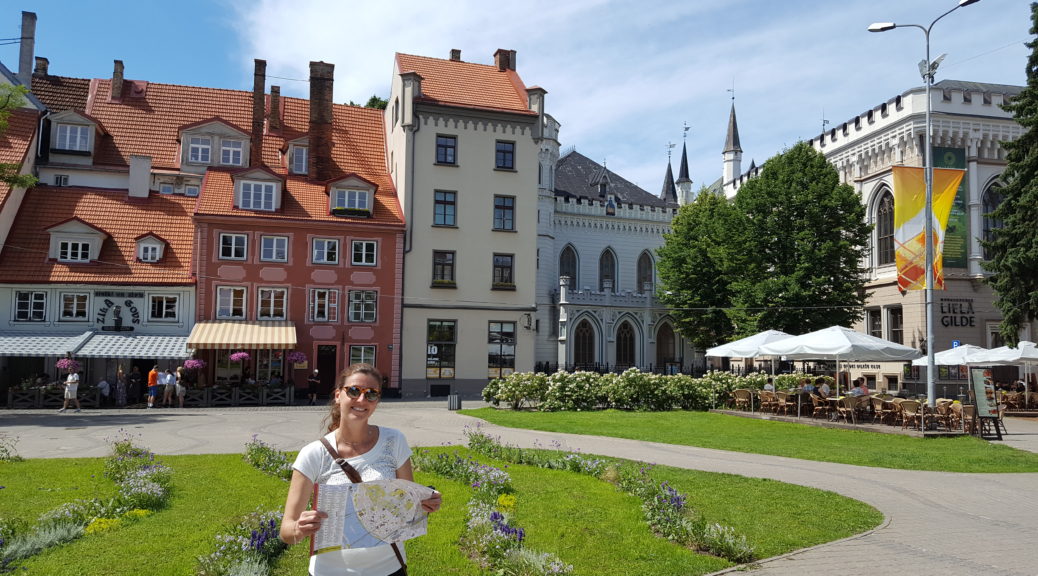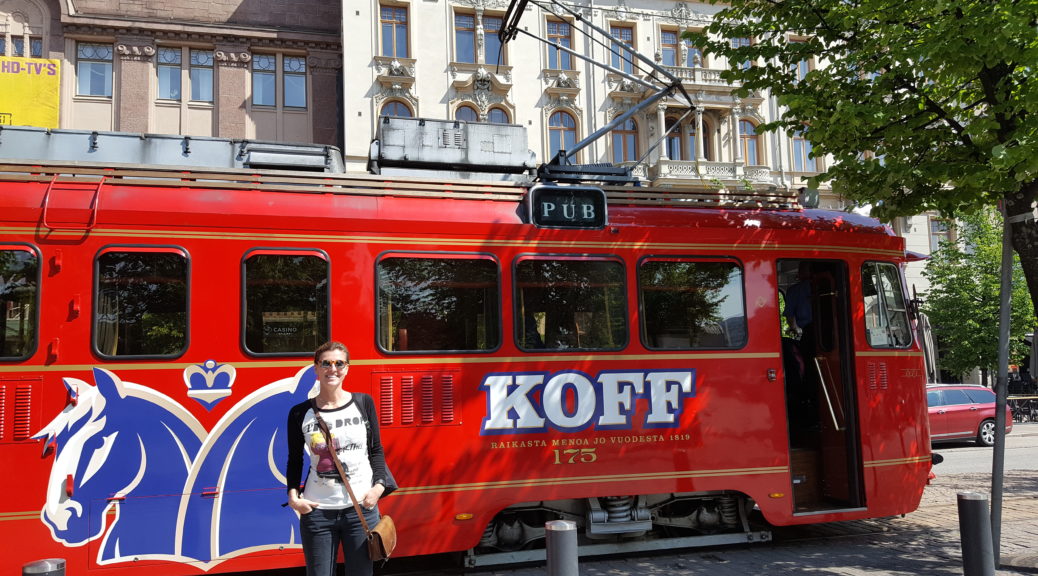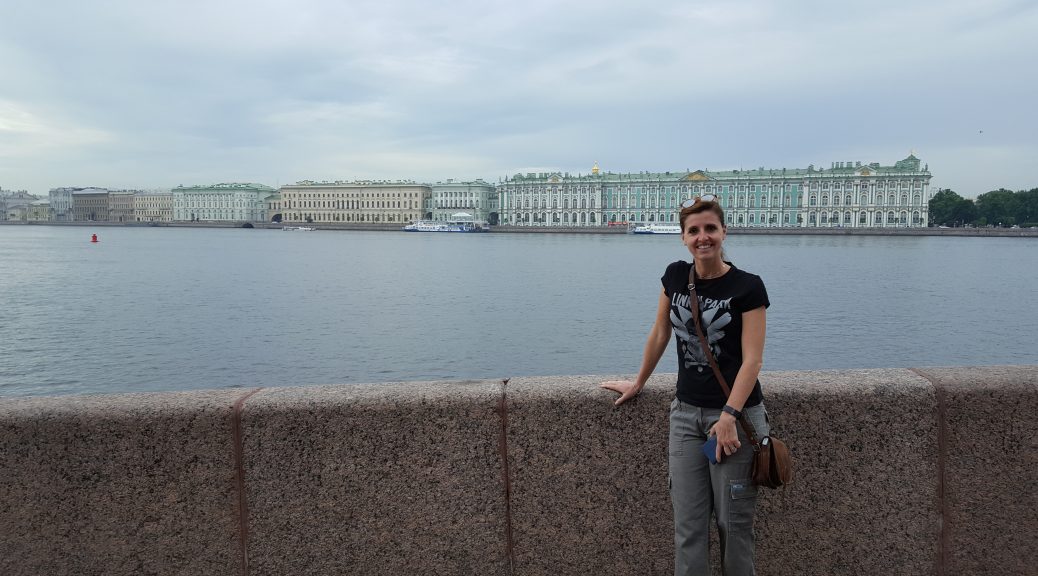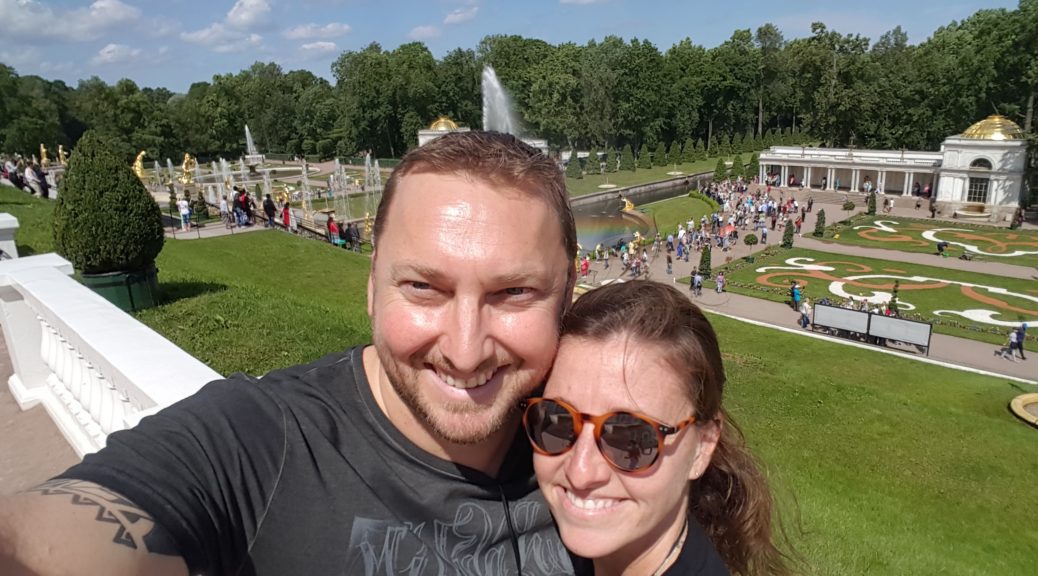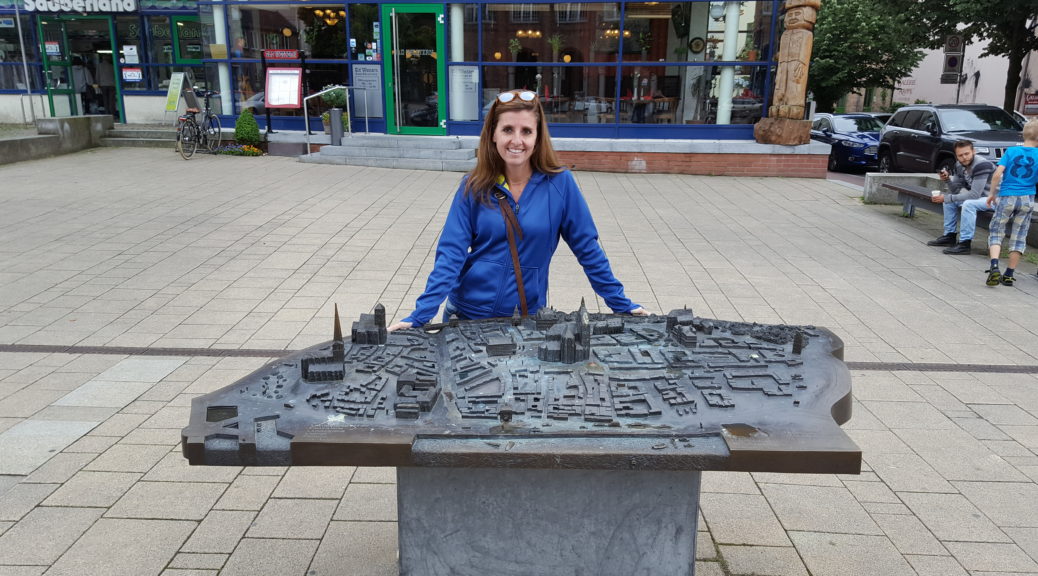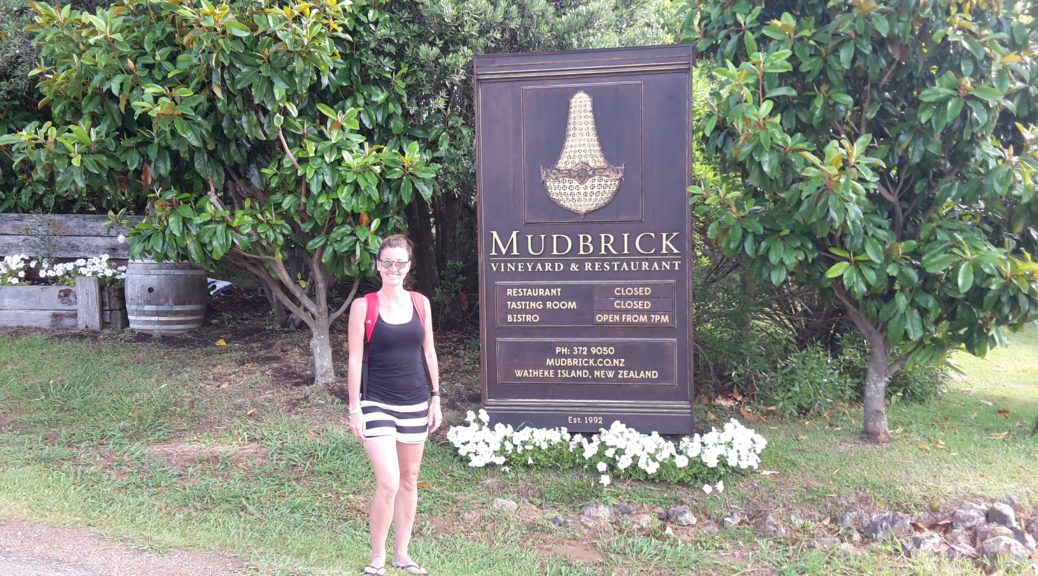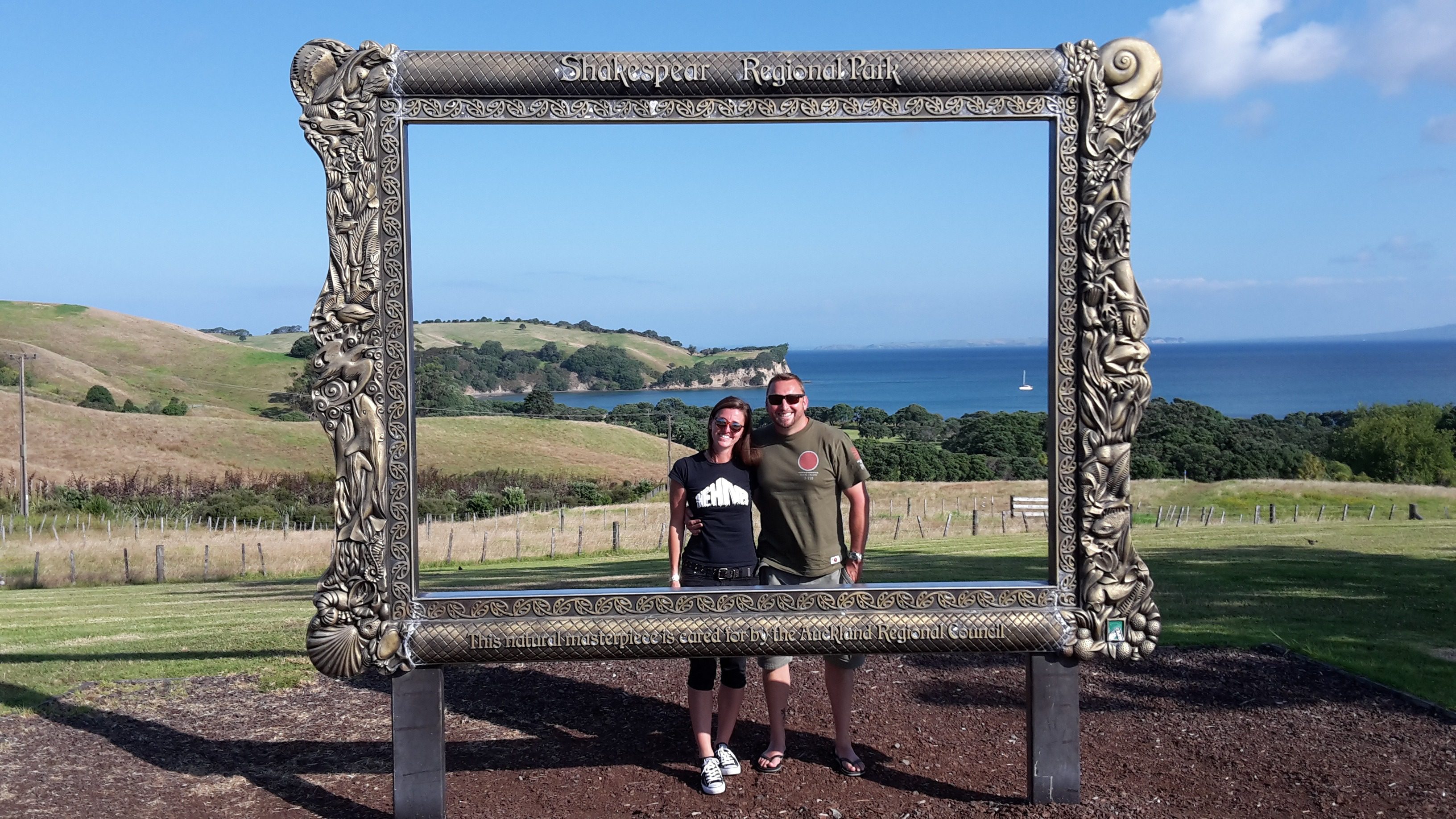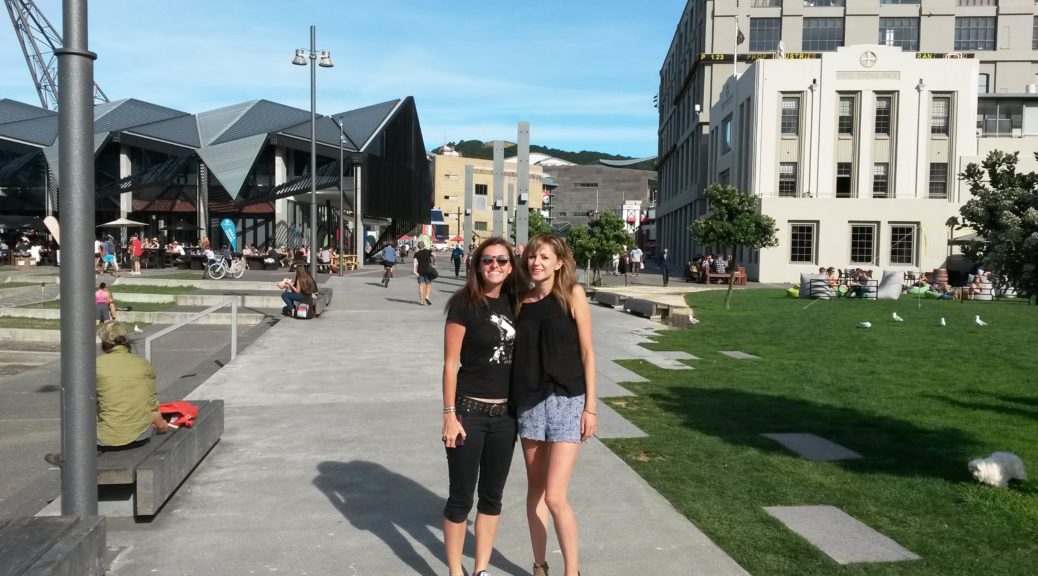The Baltic cruise had actually originally been our second choice for honeymoon destination (behind a Costa Rica and Panama combination), but trumped thanks to our – in retrospect very wise – decision to opt for the “one stop shopping” cruise option. The first half of the year had been very hectic, so having a single booking translate into the majority of an itinerary was an absolute blessing! (Not that all the busyness has prevented us from booking our next 3 getaways already, mind! 😀 )
Quite used to our usual double-barrel flight arrangements through Dubai, the journey was as painless as any, marred only slightly by my sinus infection’s insistence on using cabin pressure as a valid reason to flare up, leaving me gasping for breath, sniffing and sneezing. Fortunately we had a row to ourselves, so tissue plugs in the nostrils and full horizontal allowed me to sleep through the worst of it. A very glamorous and romantic start to the honeymoon indeed!
We arrived to a very moderate 20 degree Copenhagen. As per pilot’s update, a smattering of cumulonimbus threatening some light late afternoon showers in an otherwise perfectly pleasant day.
The airport was really tourist-friendly with English translations on all the signage and simple options on how to move from the airport to Copenhagen Central (or catch a train to Sweden, or a host of other presumably popular options).
We mastered the automated ticketing machine and were soon headed to Track 2, which we trusted was the correct one since we arrived to a platform of tourists all equally unsure of the same decision – and all audibly joyous (little more than 10 minutes later) as we all pulled into the Central Station, as planned.
We’d picked up a tourist map at the airport and the short train ride was more than enough time to navigate our path from Central Station to our hotel, which was only a few hundred metres and an almost straight line away.
Cabinn Inn is a very functional and conveniently located hotel in a city where the word “bargain” simply did not apply to accommodation. The rooms were tiny, with a small double bed taking up the majority of the floor space, a single bunk fitted above the head of the bed and the en-suite little more than a shower head above a toilet cubicle. The Rand:Krone might literally be more or less 2:1, but you’d get way more than double the value for this R1600 room (excluding breakfast, which is another R170 each for a continental selection) back home. Nevermind though, it was just a place to rest weary heads – and, no doubt, good practice for our cruise cabin.
Denmark is a Nordic country attached to Northern Europe by a bulb of landmass, with a collection of islands – called the Danish Archipelago – stretching into the Baltic Sea. Copenhagen is the capital, situated on the Eastern side of the largest island Sjaelland (Zealand) and spilling over to the Western side of neighbouring island Amager (which is where the airport is).
Denmark is joined to Sweden by a combination of tunnel and an 8km suspension bridge over the Oresund strait which houses both rail and motorway. I could imagine this modern convenience would have been quite handy back in the 10th century when the Vikings established their little fishing village and more so in the 15th century when Christian IV started working his magic to elevate Copenhagen’s standing – and in so doing, requisitioned many of the regal buildings which were among the numerous tourist attractions in the modern city.
Our plan for the arvie was to move immediately towards the main canal (running between Sjaelland and Amager) to walk the length of the waterfront until Christian Bridge and then veer inland to meander the main city centre en route back to the hotel, catching some dinner somewhere along the way.
Well, that didn’t happen.
Mostly because a) things are a lot closer together than they appear on the map and b) there are some supremely consequential things that maps don’t show, like bridge maintenance that rendered a route unplayable. A good combination of problems to have seeing as the former diluted the latter.
Our walk was very pleasant. And a lot less traumatic than me having to bicycle, like 9 out of 10 residents of Copenhagen do, apparently. The lay of the land was very flat so consequently there were hoards of bicycles everywhere. Fortunately for us, being the middle of the work day, we saw them in slots in parking lots. Could only imagine there must have been a proper cycling rush hour before and after work!
Barely a block and we were at Kalvebod Brygge. The waterfront consisted of wide wooden decks fringing the canal on our side and what looked to be restaurants and cafes dotted along a similar waterfront on the other side of the water. There were no railings separating deck from water and there were several people socialising, sprawled out on the wood, chatting on the steps and sunning themselves on deck chairs, like the canal was a beachfront (and like it was hotter than it actually was). All very orderly good clean fun, which was probably why there were none of the usual barrage of signs prohibiting this, that and the other.
We detoured from our waterfront walk when a pole of tourist signs caught our attention with a pocket of places of interest a block or two inland and, in so doing, wandered along Hans Christian Anderson Boulevard. With the Glyptoteket and Tivoli in front of us we realised we’d come full circle, so took a turn into Ny Kongensgade figuring the ‘kongen’ bit was something to do with king, royal etc. It did. And we caught the (outside of) a few museums, churches and the Christiansborg Palace a block or so in.
We learnt that a “lapidarium” was where stone sculptures and carvings were retired to; Copenhagen’s Lapidarium of Kings is found in Christian IV’s brewhouse. We also learnt that The Glyptoteket was an art museum, built around the personal collection of Carl Jacobsen, son of the founder of Carlsberg Breweries. Combining these bits of information with a sighting of a BK billboard announcing that beer was an option of drink in their meals meant we learnt a third thing – beer was a big part of Danish culture – and a fourth thing – we were going to like this place!
We extracted ourselves from the cultural part of the walk to cross the bridge to Christianshavn, a semicircular island pocketed in the close section of Amager.
The buildings along the water on this side were quite different to their historic counterparts on the side we’d just come from, with lots of metal, glass and shiny facades. With no particular agenda in mind, we wandered along Christianhavns Canal – a bit like Amsterdam, with all the brightly coloured boats moored on either side and the bars and cafés spilling onto the streets – thinking we’d reconnect with the Sjaelland side over the next bridge.
Our plan was thwarted however when the next bridge, which also seemed to be the last bridge, was under construction. A pity too because we’d spotted a hive of activity on the other side that we wanted to check out… but now that would mean walking back all the way we came and then retracing all those footsteps on the other side. Typical.
We did also see a couple of big cruise ships docked and assumed one of them to be our destination for the next day (excitement!), so logicked that we could do that end of the waterfront along with the citadel and Little Mermaid the next day when we moved over that side to board our cruise. Thus, we followed the next part of the plan and took Borsgade towards Stroeget (the main shopping street).
All the walking had activated our appetites, but it was awkwardly too late for lunch and too early for dinner so we reverted to Old Faithful from previous travels and hit the 7Eleven. This was our first real exposure to Copenhagen prices and we got quite a fright when a slice of pizza and a Carlsberg each was about R250!
It was good (pepperoni!) pizza though and the beer was cold, so it was hard to complain when we were able to sit on the steps at the base of a regal horseman statue, in the sunshine, with a view across a pretty canal at a collection of beautiful centuries-old buildings… when one could just as easily have had to be working in the winter back home. Not that (m)any seemed to be working here – there were swarms of people “beaching” canalside!
Stroget – at 1.1km, the longest pedestrian street in Europe – stretched from Radhuspladsen (City Hall Square) where we were all the way up to Kongens Nytorv Square (the back end of Tivoli), with a healthy collection of high-street shops, restaurants and bars. We combined our sight-seeing with hunting for a dinner place, for which we were hoping to do something traditionally Danish since we only had one evening in Copenhagen.
Also, it seemed like as good a time as any to tick the traditional Guinness off our list. R312 for 2 pints of Guinness at The Dubliner officially put Copenhagen in first place on our Guinness Index!!
We had happened upon a tourist publication while in The Dubliner that suggested Vesterbro (the suburb on the far side of Tivoli) as a good destination for casual dining, which made for as good as any a next mission.
We walked a fair way down the Istedgade and didn’t see anything by way of traditional food – although by their sheer numbers, you’d think schwarmas, burgers and Italian food were local specialities! – so sought refuge in an grungy alternative bar called Simpelt V instead.
Hard to say how long we were there since it was as light as day when we left as when we arrived – our first taste of white nights on travel-fatigue day (compounded by my watery-eyed sinus haze) was very confusing!
It had also confused our bellies so, determined not to have the Tuborg and Carlsberg be our welcome dinner, we got a bacon and cheese hotdog at the 7Eleven. The Danes were as passionate about hotdogs as the Icelandics, so it was a legit bit of on-the-go dining, mastered by the 1-man-band who was working the tills, toasting our rolls and even catching a shoplifter simultaneously – easily a 3 or 4 person shift back home (and the shoplifter would have gotten away, for sure).
Flaking while it was still light felt very defeatist, especially on our first night.
… but a long night’s sleep (plus a Med Lemon, an Allergex and a generous slathering of Vicks) did me the world of good and I woke in a far better state.
THURSDAY
Pity the weather wasn’t as complicit. We woke to grey skies and it was already drizzling as we hit the streets in search of breakfast.
It was coming down a fair bit by the time we got to the top end of Stroget so we sought solace in, you guessed it, 7Eleven. It didn’t disappoint and we procured delicious fresh Danish pastries (in both sense of the word) with melt-in-your-mouth pastry, light creamy custard and rich smooth glacé icing.
With renewed vigour, Chris then very cleverly sourced us a cheapo brolly, which made our walk in the rain that much more manageable.
Beyond wanting to tick the few sightseeing boxes we’d missed the day before, our new mission was a (warm, dry) place that served smorrebrod, the Danish traditional open-faced sandwiches.
We struggled on the main shopping street since most places only serve from 11 or 11h30. We should have guessed as much from the day before where there was much advertising (and reviews in the travel guides) for brunch and lunch, which seemed to be the focal meal for the day.
We eventually came right with nondescript Restaurant and Cafe Nytorv (which I later found out is actually a bit of a heritage site, being 150 years old and one of the oldest inns in Copenhagen), where a humourless hostess looked very unimpressed that we wanted to order off the lunch menu a full half hour before time! She did begrudgingly concede – although it took so long for the food to come we thought she might be holding out until the legit serving time!
When it was served, we could see why it had taken a bit of time. Each plate was a beautifully constructed pile of things atop a dark crusty bread base. This was no simple “grilled cheese sarmie”!
Unwilling to try the adventurous traditional herring smorrebrod, we’d opted for one meat and one seafood to sample a variety. The meat one was a thick wedge of warm liver paté with sautéed mushrooms and crispy bacon; the seafood was (cold) shrimps with sliced boiled egg, caviar and lemon. Both were very tasty… but certainly not the portions one would expect Vikings commanded (especially not at R160 apiece!)
The rain had stopped, so it was a good time to get back to the hotel and make our way to the cruise ship.
It was very easy to do since the front desk called a taxi for us and we paid with credit card so didn’t have to worry about running out of or having too much currency (which was a double relief since we hadn’t drawn any cash since Copenhagen was so card-friendly).
The harbour was further on the other side than we’d thought so we didn’t get a chance to see those last few sights… but it didn’t matter because we were so excited to be at our big ship, Serenade of the Seas.
Checking in was easy enough and soon we were footloose and baggage-free, etc exploring this sea hotel that was to be home for the next 10 days.
The ship had everything we expected and more – multiple pools, multiple restaurants, countless bars, indoor and outdoor cinema, video game arcade, casino, HUGE gym, running track, basketball court, climbing wall… etc. We also ended up accidentally having (second) lunch when we wandered through the Windjammer Cafe and the curry looked and smelled too good to pass up!
By then our room was ready so we made our way to 3554 and were delighted to find that we’d been upgraded to an outer cabin, which had a porthole and lounge area – and was easily 3 times the size of our Copenhagen hotel room! Being on such a low floor, it felt from the view of the liquid horizon like we were just above the waterline. Very lush indeed!
On a less delightful note, my suitcase had already been portered to the room but, sadly, the trolley handle was broken. This compounded what can only be described as a fail for my poor luggage this trip since my personalised belly band had gone AWOL on the international flight, I’d accidentally left the pullover protective sheath cover at Cabinn Inn, Christian had lost the keys to my lock (very unlike him) and now the handle. So much for bad things happening in threes!
Guest Services were quite calm about it, gave me a form, logged the case (no pun intended) and said housekeeping would pop by to take the suitcase to the carpenter for fixing (not entirely sure what a carpenter can do for a plastic handle, but was ever hopeful and preparing to be awed).
They also dispatched a fella with a big pair of bolt cutters to clip off the offending keyless lock, so I could unpack my suitcase into the spacious wardrobe before my suitcase went off to be repaired.
With all that excitement behind us, there was little else to do but leisure in our “stateroom” and Christian utilised our lounge room and the Danish cable feed on our flat-screen telly to watch the Euro Champs England/Wales game. I’m sure most of our neighbours appreciated (I know all of our neighbours must have heard) the high-volume jubilation when “our” team won.
We joined the welcome party on main deck at 5, which was (at best) very average. We had a beer to be social and cringed at the $$ pricing and mandatory 18% gratuity on everything. Fortunately though, all meals were included in the cruise cost so it numbed the pain a bit – especially when dinner was a multi-course feast at the a la carte restaurant, as we’d chosen to do. (Nevermind the cheeky quesadilla we’d munched in the Park Cafe in the Solarium en route to dinner! It was impossible to go more than a few hundred metres on the ship without eating *something*!)
After dinner we caught a show in the Tropical Theatre. It was a frothy variety show featuring all the artists doing full shows during the duration of the cruise. Great idea to help (us) decide what to hit and what to miss.
The cruise director gave us the stats on the nationalities on the guestlist. Over a thousand Americans in the overwhelming lead, with British in second, Canadians in third and a handful of Spanish-speaking countries peppering most of the remaining Top 10 slots. No mention of Saffas; guess we had the sorry state of the Rand to thank for that!
